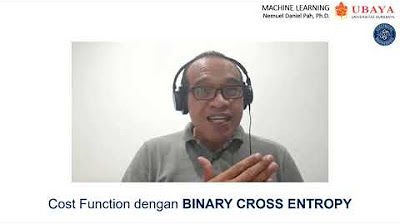A Short Introduction to Entropy, Cross-Entropy and KL-Divergence
Summary
TLDRIn this video, Aurélien Géron explores key concepts from information theory, including entropy, cross-entropy, and KL-divergence, and their applications in machine learning. He begins with an introduction to entropy as a measure of uncertainty and the average amount of information from probability distributions. Cross-entropy is explained as the average message length when communicating data, while KL-divergence measures the difference between predicted and true probability distributions. Géron then demonstrates how cross-entropy loss functions are used in training classifiers, providing a clear and informative overview of these critical topics.
Takeaways
- 📊 Cross-entropy is a common cost function in machine learning, especially for training classifiers.
- 🧠 The concepts of entropy, cross-entropy, and KL-divergence come from Claude Shannon's Information Theory.
- 💡 Entropy measures the average amount of information you get from a given probability distribution, and how unpredictable it is.
- 🌦️ A weather station example helps explain entropy by showing how uncertainty decreases with more information about future weather.
- 🔢 Cross-entropy calculates the average message length when transmitting data and compares the true distribution with the predicted one.
- 📉 Cross-entropy is higher when the predicted and true distributions differ, and the difference is measured by KL-divergence.
- 🔍 In machine learning, cross-entropy loss (or log loss) measures the error between the predicted probabilities and the true labels in classification problems.
- 📉 KL-divergence represents the difference between the cross-entropy and entropy, indicating inefficiency in coding or prediction.
- 🖼️ In a classifier, if the predicted probability for the correct class is low, the cost (cross-entropy) will be high.
- 📚 Cross-entropy loss is important in optimizing classifiers, as minimizing it improves the accuracy of predicted probabilities.
Q & A
What is entropy in the context of information theory?
-Entropy is a measure of the average amount of information or uncertainty in a probability distribution. It represents how unpredictable the distribution is. In the weather example, if the weather is highly unpredictable, the entropy is larger; if it's mostly the same, the entropy is low.
How does entropy relate to the amount of useful information received?
-Entropy measures the average amount of useful information obtained from a source. If the source reduces uncertainty significantly (like predicting a rare weather event), it provides more useful information, which increases the entropy. When the outcome is predictable, less useful information is transmitted, resulting in lower entropy.
What is cross-entropy, and how does it differ from entropy?
-Cross-entropy is the average message length based on a predicted probability distribution. It differs from entropy because it measures the inefficiency of using a predicted distribution to encode messages about a true distribution. If the predicted and true distributions are the same, cross-entropy equals entropy.
How is cross-entropy used in machine learning?
-In machine learning, cross-entropy is used as a loss function for training classifiers. The cross-entropy loss measures the difference between the predicted probabilities and the true class labels, penalizing incorrect predictions by increasing the loss.
What is the KL-divergence, and how is it related to cross-entropy?
-KL-divergence (Kullback-Leibler Divergence) measures the difference between two probability distributions. It is the additional amount of information required when using a predicted distribution (q) instead of the true distribution (p). KL-divergence is equal to the difference between the cross-entropy and the entropy.
Why is minimizing cross-entropy important in machine learning?
-Minimizing cross-entropy ensures that the predicted probability distribution is as close as possible to the true distribution, leading to better predictions. In supervised learning, reducing cross-entropy loss improves the accuracy of classifiers.
How does cross-entropy handle one-hot vectors in supervised learning?
-For one-hot vectors, where one class has a probability of 100% and the others are 0%, cross-entropy simplifies to the negative log of the predicted probability for the true class. This penalizes models that assign low probabilities to the correct class.
How does entropy change when the probabilities of outcomes are unequal?
-When probabilities of outcomes are unequal, the amount of information gained from each outcome varies. For rare events, you gain more information, leading to higher entropy for that outcome. In contrast, more likely events contribute less to entropy.
What is the significance of Shannon's Information Theory in modern digital communication?
-Shannon's Information Theory provides the mathematical foundation for efficiently and reliably transmitting data in the digital age. By quantifying information in terms of bits and optimizing encoding schemes based on probability distributions, it enables effective communication with minimal redundancy and error.
Can you explain how the example of the weather station relates to cross-entropy?
-The weather station example illustrates how cross-entropy reflects the inefficiency of encoding information. If the weather station assumes a uniform distribution for weather outcomes (3 bits for 8 states), but the true distribution is skewed (e.g., 75% sunny), the encoding is inefficient. Adjusting the message lengths based on the true probabilities reduces the cross-entropy.
Outlines

This section is available to paid users only. Please upgrade to access this part.
Upgrade NowMindmap

This section is available to paid users only. Please upgrade to access this part.
Upgrade NowKeywords

This section is available to paid users only. Please upgrade to access this part.
Upgrade NowHighlights

This section is available to paid users only. Please upgrade to access this part.
Upgrade NowTranscripts

This section is available to paid users only. Please upgrade to access this part.
Upgrade NowBrowse More Related Video
5.0 / 5 (0 votes)





